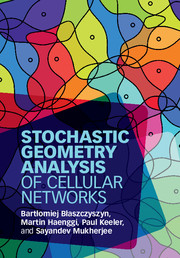Crossref Citations
This Book has been
cited by the following publications. This list is generated based on data provided by Crossref.
Keeler, H. P.
Jahnel, B.
Maye, O.
Aschenbach, D.
and
Brzozowski, M.
2018.
Disruptive events in high-density cellular networks.
p.
1.
Haroon, Muhammad Sajid
Abbas, Ziaul Haq
Abbas, Ghulam
and
Muhammad, Fazal
2018.
Analysis of Interference Mitigation in Heterogeneous Cellular Networks using Soft Frequency Reuse and Load Balancing.
p.
1.
Dettmann, Carl P.
Georgiou, Orestis
and
Pratt, Pete
2018.
Spatial networks with wireless applications
.
Comptes Rendus. Physique,
Vol. 19,
Issue. 4,
p.
187.
Zabini, Flavio
Pasolini, Gianni
De Castro, Cristina
and
Andrisano, Oreste
2018.
On Molecular Communications via Diffusion with Multiple Transmitters and Multiple Receivers.
p.
206.
Saha, Chiranjib
Dhillon, Harpreet S.
Miyoshi, Naoto
and
Andrews, Jeffrey G.
2019.
Unified Analysis of HetNets Using Poisson Cluster Processes Under Max-Power Association.
IEEE Transactions on Wireless Communications,
Vol. 18,
Issue. 8,
p.
3797.
Blaszczyszyn, Bartlomiej
and
Karray, Mohamed Kadhem
2019.
Performance Analysis of Cellular Networks With Opportunistic Scheduling Using Queueing Theory and Stochastic Geometry.
IEEE Transactions on Wireless Communications,
Vol. 18,
Issue. 12,
p.
5952.
George, Geordie
Lozano, Angel
and
Haenggi, Martin
2019.
Distribution of the Number of Users per Base Station in Cellular Networks.
IEEE Wireless Communications Letters,
Vol. 8,
Issue. 2,
p.
520.
Brochard, Antoine
Blaszczyszyn, Bartlomiej
Mallat, Stephane
and
Zhang, Sixin
2019.
Statistical learning of geometric characteristics of wireless networks.
p.
2224.
Khuntia, Pratap
and
Hazra, Ranjay
2019.
QOS aware channel and power allocation scheme for D2D enabled cellular networks.
Telecommunication Systems,
Vol. 72,
Issue. 4,
p.
543.
Abbas, Ziaul Haq
Abbas, Ghulam
Haroon, Muhammad Sajid
Muhammad, Fazal
and
Kim, Sunghwan
2019.
Proactive Uplink Interference Mitigation in HetNets Stressed by Uniformly Distributed Wideband Jammers.
Electronics,
Vol. 8,
Issue. 12,
p.
1496.
Wang, Yuanjie
Haenggi, Martin
and
Tan, Zhenhui
2019.
SIR Meta Distribution of $K$ -Tier Downlink Heterogeneous Cellular Networks With Cell Range Expansion.
IEEE Transactions on Communications,
Vol. 67,
Issue. 4,
p.
3069.
Muhammad, Fazal
Haroon, Muhammad Sajid
Abbas, Ziaul Haq
Abbas, Ghulam
and
Kim, Sunghwan
2019.
Uplink Interference Management for Hetnets Stressed by Clustered Wide-Band Jammers.
IEEE Access,
Vol. 7,
Issue. ,
p.
182679.
Miyoshi, Naoto
2019.
Downlink Coverage Probability in Cellular Networks With Poisson–Poisson Cluster Deployed Base Stations.
IEEE Wireless Communications Letters,
Vol. 8,
Issue. 1,
p.
5.
Rajanna, Amogh
and
Dettmann, Carl P.
2019.
Adaptive Transmission in Cellular Networks: Fixed-Rate Codes With Power Control Versus Physical Layer Rateless Codes.
IEEE Transactions on Wireless Communications,
Vol. 18,
Issue. 6,
p.
3005.
Jia, Xiangdong
Ji, Pengshan
and
Chen, Yuwan
2019.
Modeling and Analysis of Multi-Tier Clustered Millimeter-Wave Cellular Networks With User Classification for Large-Scale Hotspot Area.
IEEE Access,
Vol. 7,
Issue. ,
p.
140278.
Blaszczyszyn, B.
and
Keeler, H.P.
2019.
Determinantal thinning of point processes with network learning applications.
p.
1.
Ali, Konpal Shaukat
Haenggi, Martin
ElSawy, Hesham
Chaaban, Anas
and
Alouini, Mohamed-Slim
2019.
Downlink Non-Orthogonal Multiple Access (NOMA) in Poisson Networks.
IEEE Transactions on Communications,
Vol. 67,
Issue. 2,
p.
1613.
Al-Hourani, Akram
and
Haenggi, Martin
2019.
Performance of Next-Generation Cellular Networks Guarded With Frequency Reuse Distance.
IEEE Transactions on Communications,
Vol. 67,
Issue. 10,
p.
7277.
Okati, Niloofar
Riihonen, Taneli
Korpi, Dani
Angervuori, Ilari
and
Wichman, Risto
2020.
Downlink Coverage and Rate Analysis of Low Earth Orbit Satellite Constellations Using Stochastic Geometry.
IEEE Transactions on Communications,
Vol. 68,
Issue. 8,
p.
5120.
Mankar, Praful D.
and
Dhillon, Harpreet S.
2020.
Downlink Analysis of NOMA-Enabled Cellular Networks With 3GPP-Inspired User Ranking.
IEEE Transactions on Wireless Communications,
Vol. 19,
Issue. 6,
p.
3796.



